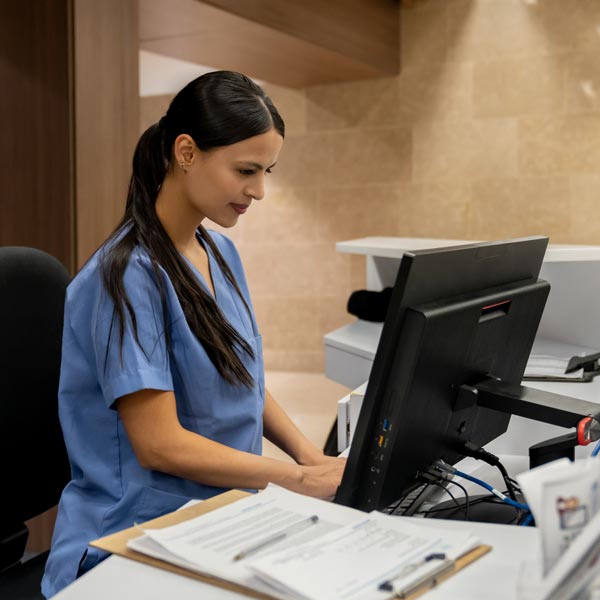Medical Assisting
Support the Work of Health Professionals by Performing Clinical & Administrative Work
The Medical Assisting Program is designed to prepare students to be able to successfully serve in both front and back-office functions within the health care industry, in medical offices, clinics and agencies. Students successfully completing this program will be able to perform the front office administrative tasks of a medical receptionist, including such functions as registering new patients, using proper telephone techniques, scheduling appointments, preparing and updating medical records and reports, and billing and coding. Students successfully completing this program will also be able to perform many back-office functions such as: taking and recording vital signs, using proper sterile techniques, performing phlebotomy, working as ECG/EKG technicians, handling specimens, performing a urinalysis, conducting proper medication dosage calculations, and administration.
Students will also be learning Medical Terminology, Anatomy and Physiology, and will be earning their Heartcode BLS Certificate and Mental Health First Aid Certificate. Essentially all the skills needed to assist in the modern Medical Office will be addressed. In general, the first semester is all about learning Anatomy and Physiology, as well as front office functions. During the second semester, students learn about back office skills, including Phlebotomy and ECG/EKG. Also during the second semester, students will have the opportunity to apply and be chosen to participate in a 160 hour Summer Clinical/Internship.
Program Flyer Steps for Enrollment Pickens Lookbook See the Classroom Background Check Modification

What Our Students Learn
- Assisting in minor surgical procedures
- Vision and hearing testing
- Injections
- Cast application and removal
- Understanding of medical terminology, anatomy, and physiology
- Emergency procedures and first aid
- Perform back office functions such as: phlebotomy, medical filing, ECG/EKG machines, and specimen handling and testing
- Medication administration and dosage calculations

Career Outlook
- Employment opportunity in this field is 9 times higher than the national average of a job
- Entry level salaries start at $29,000 and up
- Median salary is $38,000
- 10% of workers earn $50,000 or more

Program Experience
- Students spend 50% of their time learning concepts in a classroom, and 50% of their time with hands-on practical work
- Students gain experience in a simulated medical environment with industry-grade equipment
- Students are prepared for their CCMA certification as part of the curriculum
- Enrollment options are available for both high school students and post-secondary students
- 1 year of classes
Vanessa Partida
Instructor, Medical Assisting
303-344-4910 ext. 27718
vpartida@aurorak12.org
Industry Certifications & Degrees:
- Registered Medical Assistant
- Cross-trained as Lab technician
- Cross-trained as Surgical technician
Accredited Certificate Courses (34.5 credits)
All credits earned at Pickens technical college are recognized by the Colorado Community College System (CCCS), and are eligible for transfer to other colleges within the state of Colorado.
Meets the requirements for American Red Cross Professional Rescuer CPR or American Heart Association Basic Life Support for those who work in Emergency Services, Health Care, and other professional areas. Material presented in this course is basic patient assessment, basic airway management, rescue breathing, AED use, and CPR for infant, children, and adult patients.
Introduces the student to the structure of medical terms with emphasis on combining and using the most common prefixes, roots, and suffixes. Includes terms related to the clinical laboratory, diagnostic imaging, nuclear medicine, and oncology, as well as major body systems. Classroom structure provides accepted pronunciation of terms and relative use in the healthcare setting.
Introduces the administrative duties specifically used in medical offices.
Introduces the student to basic routine laboratory skills and techniques for collection, handling, and examination of laboratory specimens often encountered in the ambulatory care setting. Emphasizes hands-on experience.
Provides hands-on experience with the clinical skills required for assisting with patient care. Delivers the theory behind each skill presented as well as proper technique for performing each skill.
Provides an overview of pharmacology language, abbreviations, systems of measurement, and conversions. The Controlled Substances Act, prescriptions, forms of medications, patient care applications, drug classifications/interactions, and safety in drug therapy and patient care are presented. Information regarding the measurement of medications, dosage calculations, routes of administration, and commonly prescribed drugs in the medical office is provided.
Teaches anatomy and physiology, pathophysiology, and drug therapy of the immune, musculoskeletal, and digestive systems. A discussion of pediatric implications as they relate to clinical physiology will also be covered.
Introduces outpatient coding with an ultimate goal to present a clear picture of medical procedures and services performed (CPT codes), correlating the diagnosis, symptom, complaint, or condition (ICD-9 codes), thus establishing the medical necessity required for third-party reimbursement.
Teaches anatomy and physiology, pathophysiology, and drug therapy of the cardiovascular, respiratory, and dermatology systems.
Covers the anatomy and physiology, pathophysiology, and drug therapy of the Renal, Reproductive, Neurological, and Endocrine systems.
Provides hands-on experience with the basic clinical skills required for assisting with patient care in an ambulatory setting. Delivers the theory behind each skill presented as well as proper technique for performing each skill. Includes knowledge and/or performance of universal precautions/ OSHA regulations, HIPAA, medical asepsis, procedural gowning and gloving, patient draping and positioning, and measurement of vital signs.
Prepares the candidate sitting for the National Registration/Certification Examination for Medical Assistant through review and practice. These examinations are given with the intent of evaluating the competency of entry-level practitioners in Medical Assisting, therefore supporting quality care in the office or clinic.
Emphasizes syntheses of the information and skills that students learned throughout the Medical Assisting program.